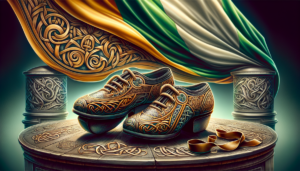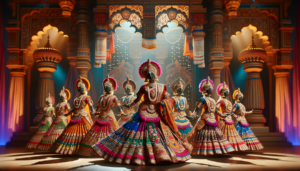Dance is an integral part of human history, transcending rituals and fostering community. As an expressive physical art form, dance has evolved over time, reflecting the cultural, social, and artistic influences of each era. From ancient tribal dances to modern performances, the history of dance is a fascinating journey that showcases the universal elements of rhythm, movement, and expression.
Introduction to Dance History
The Origins of Dance
Dance has been a part of human culture since the earliest civilizations. Ancient cave paintings depict figures engaged in what appear to be ritualistic dances, suggesting that dance played a significant role in early human societies. These dances were often linked to spirituality, hunting, and celebrations, serving as a means of communication and expression.
As civilizations developed, dance became more structured and formalized. In ancient Egypt, for example, dance was an integral part of religious ceremonies and festivals. The Greeks and Romans also incorporated dance into their theatrical performances and social gatherings.
Dance as a Cultural and Social Phenomenon
Throughout history, dance has served as a reflection of cultural identity and social norms. Each culture has its own unique dance forms and traditions, often passed down through generations. These dances tell stories, celebrate life events, and express emotions.
In many societies, dance has also played a crucial role in social interactions. Courtship dances, such as the waltz and tango, have been used to facilitate romantic connections. Social dances, like the square dance and the cha-cha, have brought communities together and fostered a sense of belonging.
The Evolution of Dance Through Time
Ancient and Medieval Dance Forms
The evolution of dance can be traced back to ancient civilizations. In India, classical dance forms such as Bharatanatyam and Kathak have roots dating back thousands of years. These dances, originally performed in temples, tell stories from Hindu mythology and express devotion to the gods.
| Dance Form | Origin | Characteristics |
|---|---|---|
| Bharatanatyam | India | Expressive hand gestures, facial expressions, and rhythmic footwork |
| Kathak | India | Intricate footwork, spins, and storytelling through hand gestures |
In medieval Europe, dance was often associated with courtly life and religious celebrations. Court dances, such as the pavane and the galliard, were performed by the nobility and reflected the elegance and refinement of the era. Religious dances, like the carol and the round, were performed during festivals and processions.
Renaissance and Baroque Dance
The Renaissance period saw a resurgence of interest in the arts, including dance. Ballet, which originated in the Italian courts, began to take shape as a formalized art form. The first ballet, “Le Ballet Comique de la Reine,” was performed in 1581 and featured elaborate costumes and intricate choreography.
During the Baroque era, dance continued to evolve and became more theatrical. The French court, under King Louis XIV, became the center of dance innovation. Ballet d’action, which told stories through movement and gesture, emerged as a new style. Choreographers like Jean-Baptiste Lully and Pierre Beauchamp codified ballet technique and established the five basic positions of the feet.
Modern and Contemporary Dance
The 20th century brought significant changes to the world of dance. Modern dance pioneers, such as Isadora Duncan and Martha Graham, rejected the strict rules of classical ballet and sought to express emotion and inner experience through movement. They developed new techniques and styles that emphasized fluidity, contraction, and release.
Contemporary dance, which emerged in the latter half of the 20th century, continues to push the boundaries of traditional dance forms. Choreographers like Merce Cunningham and Pina Bausch experimented with chance procedures, multimedia elements, and unconventional performance spaces. Today, contemporary dance encompasses a wide range of styles and influences, from street dance to performance art.
The Impact of Dance on Society
Dance as a Medium for Storytelling
Dance has long been used as a medium for storytelling, conveying narratives and emotions through movement. In many cultures, dance is used to pass down oral histories and mythologies from one generation to the next. For example, the hula dance of Hawaii tells stories of the islands’ history, legends, and natural beauty.
Theatrical dance productions, such as ballets and musicals, also use dance to advance the plot and develop characters. The choreography, music, and costumes work together to create a cohesive narrative that engages the audience on an emotional level.
Therapeutic Benefits of Dance
In addition to its artistic and cultural value, dance has been recognized for its therapeutic benefits. Dance therapy, which emerged as a distinct field in the 1940s, uses movement to promote emotional, cognitive, and physical well-being. It has been used to treat a wide range of conditions, including depression, anxiety, and Parkinson’s disease.
Dance has also been shown to improve cardiovascular health, balance, and coordination. For older adults, participating in dance classes can help prevent falls and maintain cognitive function. The social aspect of dance can also combat loneliness and isolation, promoting a sense of community and connection.
The Role of Technology in Dance
Choreography and Performance Enhancements
Technology has had a significant impact on the world of dance, transforming the way choreography is created and performances are staged. Computer software, such as Dance Forms and Life Forms, allows choreographers to visualize and experiment with movement in a virtual environment. Motion capture technology can record a dancer’s movements and translate them into digital data, which can be used for analysis and animation.
In live performances, technology has enhanced the audience experience through the use of projection mapping, LED screens, and interactive elements. The integration of video, sound, and lighting design has created immersive environments that blur the lines between dance and multimedia art.
Accessibility and Digital Platforms
Technology has also made dance more accessible to a wider audience. Online platforms, such as YouTube and Instagram, have allowed dancers to share their work and connect with fans around the world. Virtual reality experiences have brought dance performances to those who may not have access to live shows.
Dance education has also benefited from technology. Online classes and tutorials have made it possible for aspiring dancers to learn from master teachers, regardless of their location. Interactive software and video analysis tools have enabled students to receive immediate feedback and track their progress.
Dance Education and Its Importance
Promoting Creativity and Discipline
Dance education plays a crucial role in fostering creativity, discipline, and self-expression. Through dance classes, students learn to explore movement, develop their own unique style, and communicate emotions through their bodies. The discipline required to master technique and choreography also teaches valuable life skills, such as perseverance, time management, and teamwork.
Many schools have recognized the value of dance education and have incorporated it into their curricula. In addition to physical education classes, some schools offer dance as an elective or extracurricular activity. Dance programs in schools provide students with an outlet for creative expression and can help boost self-confidence and social skills.
Cultural Awareness Through Dance
Dance education also promotes cultural awareness and understanding. By learning about dance forms from different cultures, students gain insight into the histories, values, and traditions of those communities. This exposure can foster empathy, respect, and appreciation for diversity.
Many dance educators incorporate multicultural dance forms into their lessons, exposing students to a wide range of styles and influences. This approach not only broadens students’ artistic horizons but also helps them develop a global perspective and an understanding of the interconnectedness of human experience.
The Future of Dance
Fusion of Styles
As dance continues to evolve, we can expect to see a growing fusion of styles and influences. Choreographers are increasingly drawing inspiration from a wide range of sources, from traditional dance forms to popular culture and technology. This cross-pollination of ideas is leading to the creation of new, hybrid dance styles that defy categorization.
One example of this fusion is the rise of dance forms that incorporate elements of martial arts, such as capoeira and breakdancing. These styles blend the athleticism and power of combat with the grace and artistry of dance, creating a unique and dynamic form of expression.
Global Collaboration
The future of dance is also likely to be shaped by increased global collaboration and exchange. With the rise of digital platforms and social media, dancers from around the world are able to connect, share ideas, and collaborate on projects like never before. This exchange of knowledge and perspectives is enriching the dance community and leading to the creation of new, innovative works.
International dance festivals and competitions are also providing opportunities for dancers to showcase their talents and learn from their peers. These events bring together dancers from diverse backgrounds and styles, fostering a sense of global community and artistic exchange.
As dance continues to evolve and adapt to the changing world, it remains a vital and vibrant art form that has the power to inspire, heal, and unite. By embracing its rich history and looking toward the future, the dance community can continue to push boundaries, tell stories, and celebrate the beauty and diversity of human experience.






